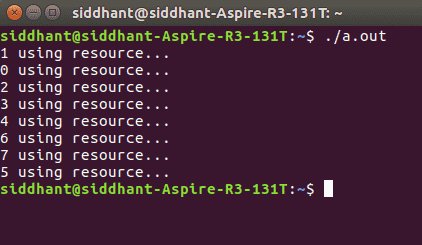null
这个 烘焙算法 是N过程一般情况下互斥问题的已知最简单解之一。烘焙算法是一个关键的部分解决方案 N 过程。该算法保留了先到先得的服务属性。
- 在进入关键区域之前,流程会收到一个数字。人数最少的持有者进入临界区。
- 如果进程Pi和Pj收到相同的数字,
if i < j Pi is served first; else Pj is served first.
- 编号方案总是以递增的枚举顺序生成数字;i、 例如,1,2,3,3,3,4,5…
符号- 字典顺序(票证号,进程id)-首先比较票证号。如果相同,则接下来比较进程ID,即-
– (a, b) < (c, d) if a < c or if a = c and b < d – max(a [0], . . ., a [n-1]) is a number, k, such that k >= a[i] for i = 0, . . ., n - 1
共享数据–选择的是一个布尔值数组[0..n–1]number是整数值的数组[0..n–1]。两者都初始化为 假&零 分别地
算法伪码-
repeat
choosing[i] := true;
number[i] := max(number[0], number[1], ..., number[n - 1])+1;
choosing[i] := false;
for j := 0 to n - 1
do begin
while choosing[j] do no-op;
while number[j] != 0
and (number[j], j) < (number[i], i) do no-op;
end;
critical section
number[i] := 0;
remainder section
until false;
解释—— 首先,该过程将其“选择”变量设置为TRUE,表明其进入临界区的意图。然后,它会被分配与其他进程对应的最高票证号。然后,“Selecting”变量被设置为FALSE,表示它现在有了一个新的票号。事实上,这是算法中最重要、最令人困惑的部分。
这实际上是一个小的关键部分本身!前三行的目的是,如果一个进程正在修改其票证值,那么此时不应允许其他进程检查其已过时的旧票证值。这就是为什么在for循环中,在检查票证值之前,我们首先确保所有其他进程的“selection”变量都为FALSE。
之后,我们继续检查进程的票证值,其中票证号/进程id最少的进程进入关键部分。出口部分只是将票证值重置为零。
代码– 下面是烘焙算法的C代码实现。在一个窗口中运行以下命令 UNIX环境 –
// Importing the thread library #include "pthread.h" #include "stdio.h" // Importing POSIX Operating System API library #include "unistd.h" #include "string.h" // This is a memory barrier instruction. // Causes compiler to enforce an ordering // constraint on memory operations. // This means that operations issued prior // to the barrier will be performed // before operations issued after the barrier. #define MEMBAR __sync_synchronize() #define THREAD_COUNT 8 volatile int tickets[THREAD_COUNT]; volatile int choosing[THREAD_COUNT]; // VOLATILE used to prevent the compiler // from applying any optimizations. volatile int resource; void lock( int thread ) { // Before getting the ticket number //"choosing" variable is set to be true choosing[ thread ] = 1; MEMBAR; // Memory barrier applied int max_ticket = 0; // Finding Maximum ticket value among current threads for ( int i = 0; i < THREAD_COUNT; ++i) { int ticket = tickets[i]; max_ticket = ticket > max_ticket ? ticket : max_ticket; } // Allotting a new ticket value as MAXIMUM + 1 tickets[ thread ] = max_ticket + 1; MEMBAR; choosing[ thread ] = 0; MEMBAR; // The ENTRY Section starts from here for ( int other = 0; other < THREAD_COUNT; ++other) { // Applying the bakery algorithm conditions while (choosing[other]) { } MEMBAR; while (tickets[other] != 0 && (tickets[other] < tickets[ thread ] || (tickets[other] == tickets[ thread ] && other < thread ))) { } } } // EXIT Section void unlock( int thread ) { MEMBAR; tickets[ thread ] = 0; } // The CRITICAL Section void use_resource( int thread ) { if (resource != 0) { printf ( "Resource was acquired by %d, but is still in-use by %d!" , thread , resource); } resource = thread ; printf ( "%d using resource..." , thread ); MEMBAR; sleep(2); resource = 0; } // A simplified function to show the implementation void * thread_body( void * arg) { long thread = ( long )arg; lock( thread ); use_resource( thread ); unlock( thread ); return NULL; } int main( int argc, char ** argv) { memset (( void *)tickets, 0, sizeof (tickets)); memset (( void *)choosing, 0, sizeof (choosing)); resource = 0; // Declaring the thread variables pthread_t threads[THREAD_COUNT]; for ( int i = 0; i < THREAD_COUNT; ++i) { // Creating a new thread with the function //"thread_body" as its thread routine pthread_create(&threads[i], NULL, &thread_body, ( void *)(( long )i)); } for ( int i = 0; i < THREAD_COUNT; ++i) { // Reaping the resources used by // all threads once their task is completed ! pthread_join(threads[i], NULL); } return 0; } |
输出: 
© 版权声明
文章版权归作者所有,未经允许请勿转载。
THE END


![关于”PostgreSQL错误:关系[表]不存在“问题的原因和解决方案-yiteyi-C++库](https://www.yiteyi.com/wp-content/themes/zibll/img/thumbnail.svg)



